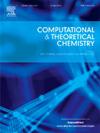InxGa1-xN和mg掺杂InxGa1-xN的晶体结构和稳定性:第一性原理计算
IF 3
3区 化学
Q3 CHEMISTRY, PHYSICAL
引用次数: 0
摘要
研究了不同In组成的InGaN晶体及其p型掺杂物的基态构型和电子特性。在CASTEP中实现了第一性原理计算框架,并通过与已有实验数据的直接比较验证了其可靠性。计算表明,InxGa1-xN和InxGa1-xN:Mg晶体的结构稳定性主要受组成原子类型的影响,而晶格位占用对结构稳定性的影响相对较小。对InxGa1-xN和InxGa1-xN:Mg晶体的成键机制进行了揭示和分析,发现这些异核键主要来自金属sp态和氮p态之间的轨道杂化。此外,还揭示了随In含量增加而降低的稳定性源于双重机制:化学取代效应和晶格应变引起的普遍“膨胀效应”。本研究为富in氮化物的不稳定性提供了一个基本的解释,为光电器件的设计提供了理论基础。本文章由计算机程序翻译,如有差异,请以英文原文为准。

Crystal structures and stabilities of InxGa1-xN and Mg-doped InxGa1-xN: A first-principles calculation
The ground-state configurations and electronic characteristics of InGaN crystals with varying In compositions and their p-type doped counterparts were investigated. A first-principles computational framework was implemented in CASTEP, with its reliability validated through direct comparison with prior experimental data. The calculations demonstrate that the structural stabilities of InxGa1-xN and InxGa1-xN:Mg crystals are predominantly governed by the type of constituent atoms, while lattice site occupancy exerts relatively minor influence on structural stability. Bonding mechanisms of InxGa1-xN and InxGa1-xN:Mg crystals were revealed and analyzed, finding that these heteronuclear bonds predominantly arise from orbital hybridization between metal sp-states and nitrogen p-states. Furthermore, it is revealed that the decreasing stability with increasing In content originates from a twofold mechanism: a chemical substitution effect and a universal “expansion effect” caused by lattice strain. This work provides a fundamental explanation for the instability of In-rich nitrides, offering a theoretical foundation for the design of optoelectronic devices.
求助全文
通过发布文献求助,成功后即可免费获取论文全文。
去求助
来源期刊

Computational and Theoretical Chemistry
CHEMISTRY, PHYSICAL-
CiteScore
4.20
自引率
10.70%
发文量
331
审稿时长
31 days
期刊介绍:
Computational and Theoretical Chemistry publishes high quality, original reports of significance in computational and theoretical chemistry including those that deal with problems of structure, properties, energetics, weak interactions, reaction mechanisms, catalysis, and reaction rates involving atoms, molecules, clusters, surfaces, and bulk matter.
 求助内容:
求助内容: 应助结果提醒方式:
应助结果提醒方式:


